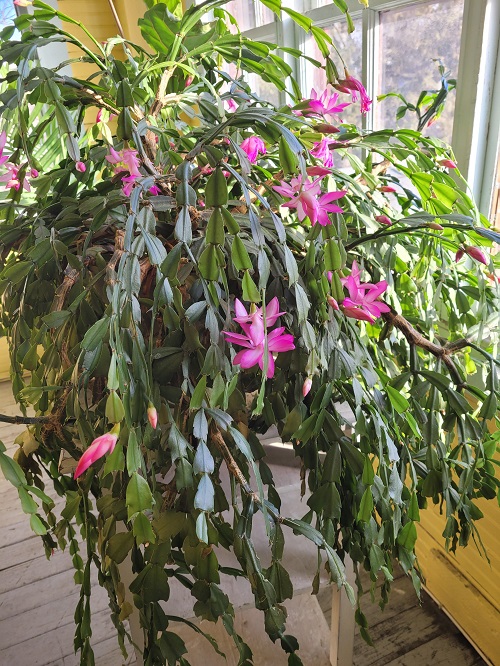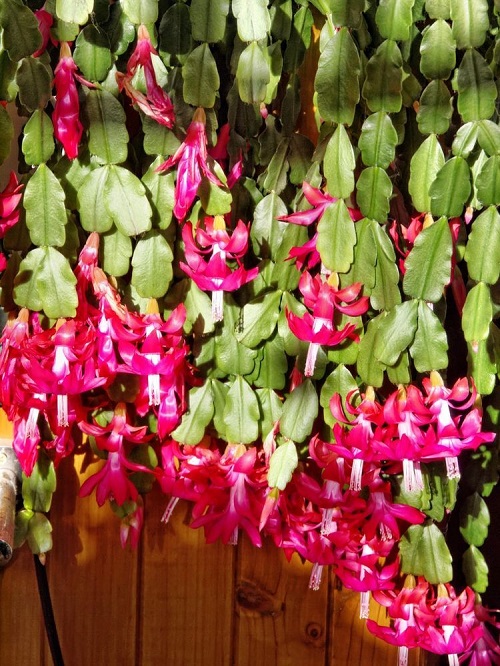Not sure How to Feed Your Christmas Cactus? Learn about this secret Fertilizing Regimen that’s followed by the Commercial Growers!
Feeding your Christmas Cactus correctly is the key to ensuring its vibrant blooms appear for a long time, year after year.
Fertilizer Regimen of Commercial Growers
Commercial plant growers have a specific fertilizing regimen for Christmas cacti (Schlumbergera bridgesii) or any other Holiday cacti.
Secret tricks for never ending Christmas cactus flowers here
1. When Do They Start Fertilizing
Most commercial growers generally start feeding Christmas cacti as soon as roots develop on newly propagated cuttings. This is an important milestone in plant propagation because feeding at this stage helps promote vegetative growth and root development.
You can start feeding your plant since early spring, usually around March or April (earlier if you live in a warmer climate) till fall. This timing aligns with the period when the cacti start to grow actively.
Discover what is the best time to put Christmas cactus in the dark here
2. Types of Fertilizers They Use
Christmas cactus doesn’t need heavy fertilization, but to grow well, it needs constant and frequent fertilization. Professional growers usually apply a balanced fertilizer with micronutrients once a month, with an aim to provide 150 ppm of nitrogen in each dose.
Additionally, they use calcium nitrate and potassium nitrate to provide 180 ppm of nitrogen, 390 ppm of potassium, and 53 ppm of calcium every time they water.
While doing all that, they also flush the growing medium with plain water to prevent the accumulation of soluble salts occasionally. If you decide to follow a similar regimen, it will be an important step to prevent salt buildup.
If you want to copy that, there will be a whole lot of conversion. You can also follow the suggestions below or follow the manufacturer’s recommendations.
3. What Should Be the Frequency?
The fertilization schedule varies throughout the year and according to the growing conditions you are providing. Generally, Christmas cacti are fertilized more frequently during their active growing season, which is typically from spring to early fall.
During this period, feed your plant every month at quarter to half strength compared to the manufacturer’s recommendation to avoid over-fertilization, which can be harmful.
You can also mix a little bit of calcium nitrate and potassium nitrate into your watering can every 2 weeks you water your plant, or more specifically, for each gallon of water, add about 1/4 to 1/2 teaspoon of calcium nitrate and 1/4 to 1/2 teaspoon of potassium nitrate.
- Always watch the response of your plant after fertilization and reduce or increase the concentration accordingly for the next time.
- It is also important to water your plant thoroughly with running water once in 2-3 months to remove excess fertilizer.
4. Fall and Winter Care
After the buds appear, reduce fertilization to prevent vegetative growth. And after the flowers arrive in the late fall and winter months or when the Christmas cactus enters an inactive phase, stop fertilization.
This rest period is crucial for the plant after it has used all its energy to bloom. This also prepares it for the upcoming blooming period next year.
5. Water Before and After Feeding
When applied to dry soil, the strong concentration of nutrients can cause “fertilizer burn,” damaging the delicate root system.
Watering the plant beforehand helps dilute the liquid fertilizer, reducing the risk of root burn. (Do note that this won’t be a problem if you are diluting it to 1/2 or 1/4 of its recommended strength)
On the contrary, if you have applied slow-release fertilizer granules, watering the soil after adding fertilizer helps distribute the nutrients evenly throughout the soil.
6. Post-Blooming Care
After the blooming phase (At the end of winter and by the start of spring), a period of reduced fertilization is crucial.
All this helps the plant to grow more vigorously, leading to a robust and well-developed structure that can support the weight of flowers during the next blooming period.
Follow these tricks to get more blooms on any plant
Conclusion

The key to lush, flowering Christmas cactus is a balanced approach to fertilization, with adjustments made based on the plant’s growth cycle, growing requirements, and conditions you are providing.


